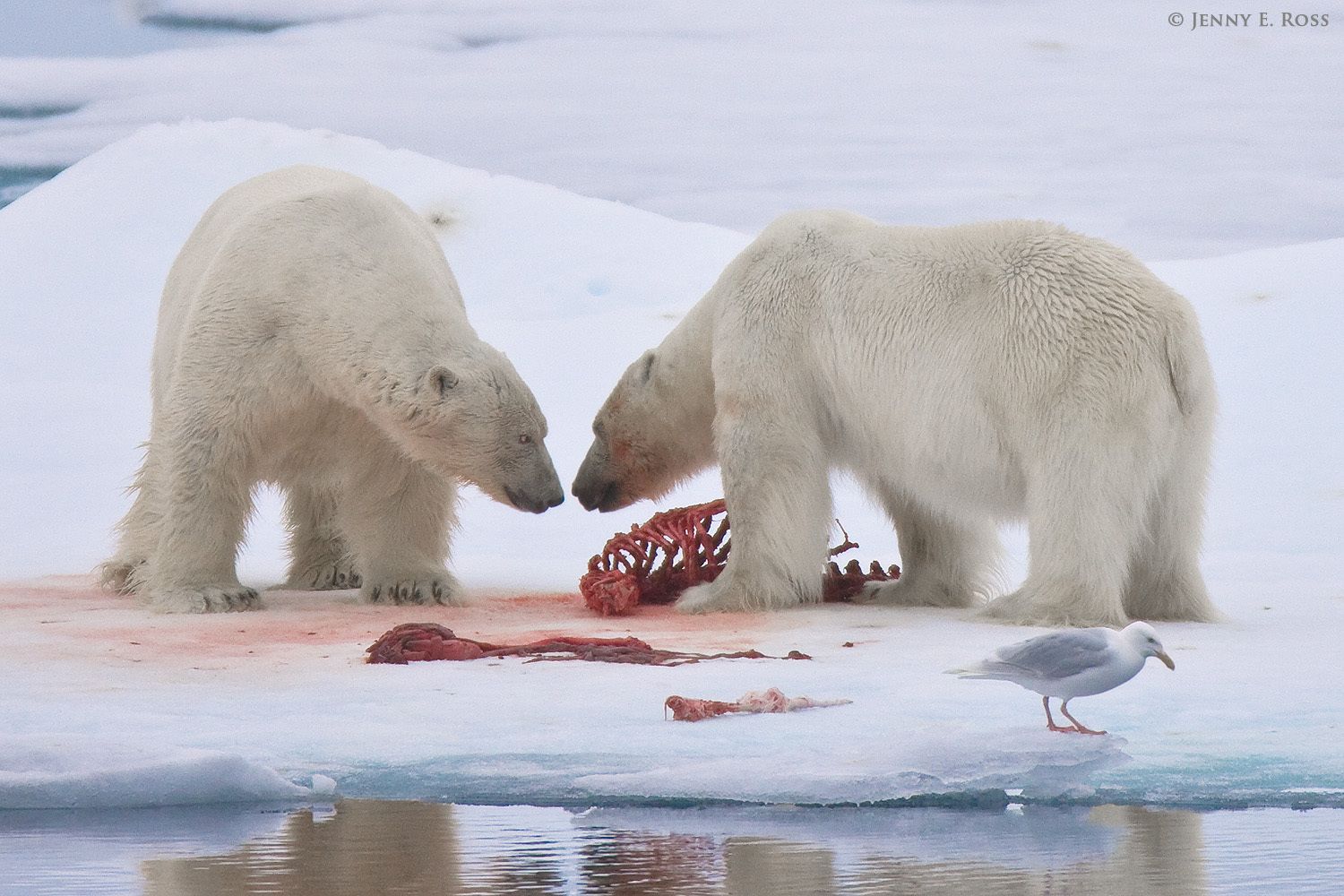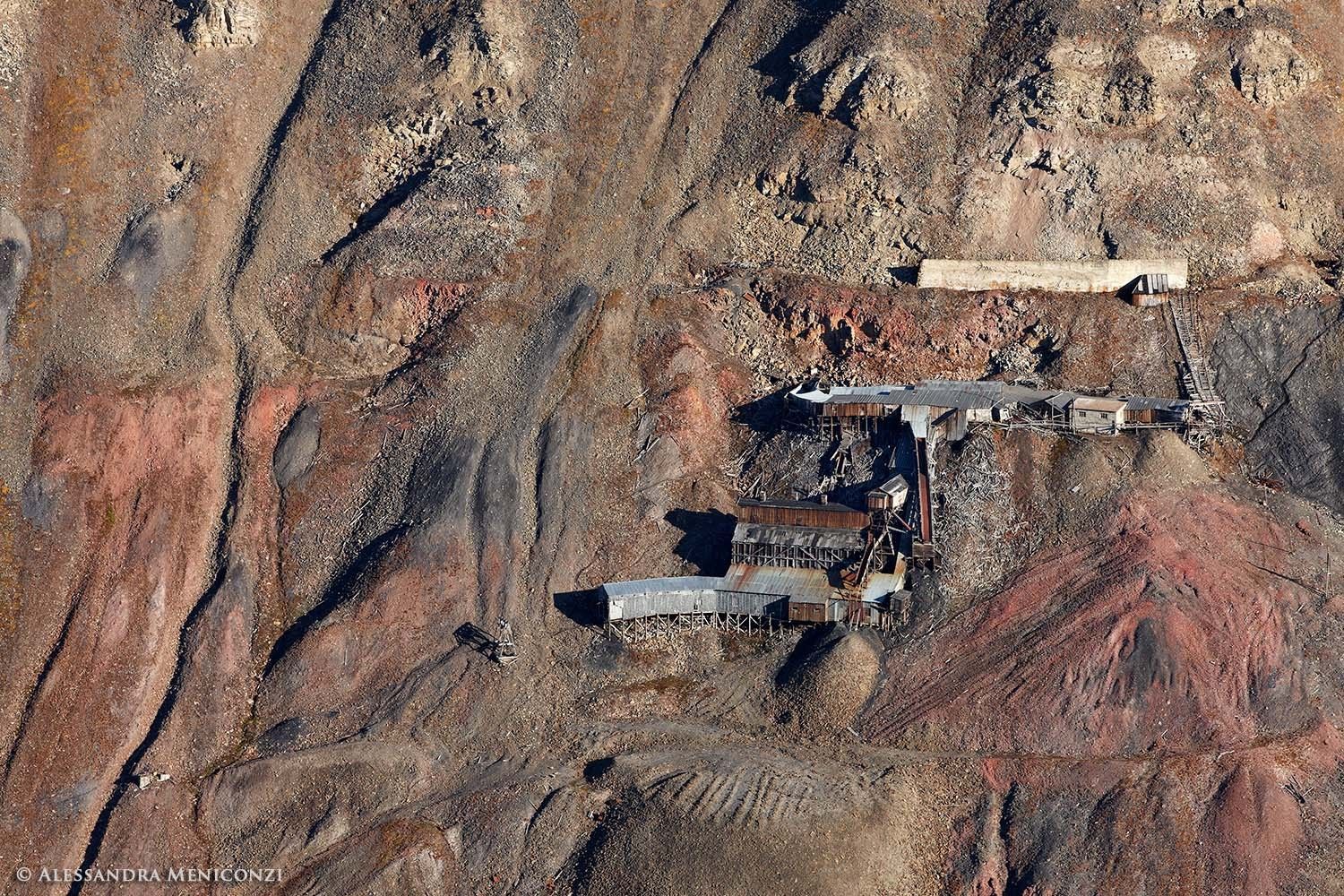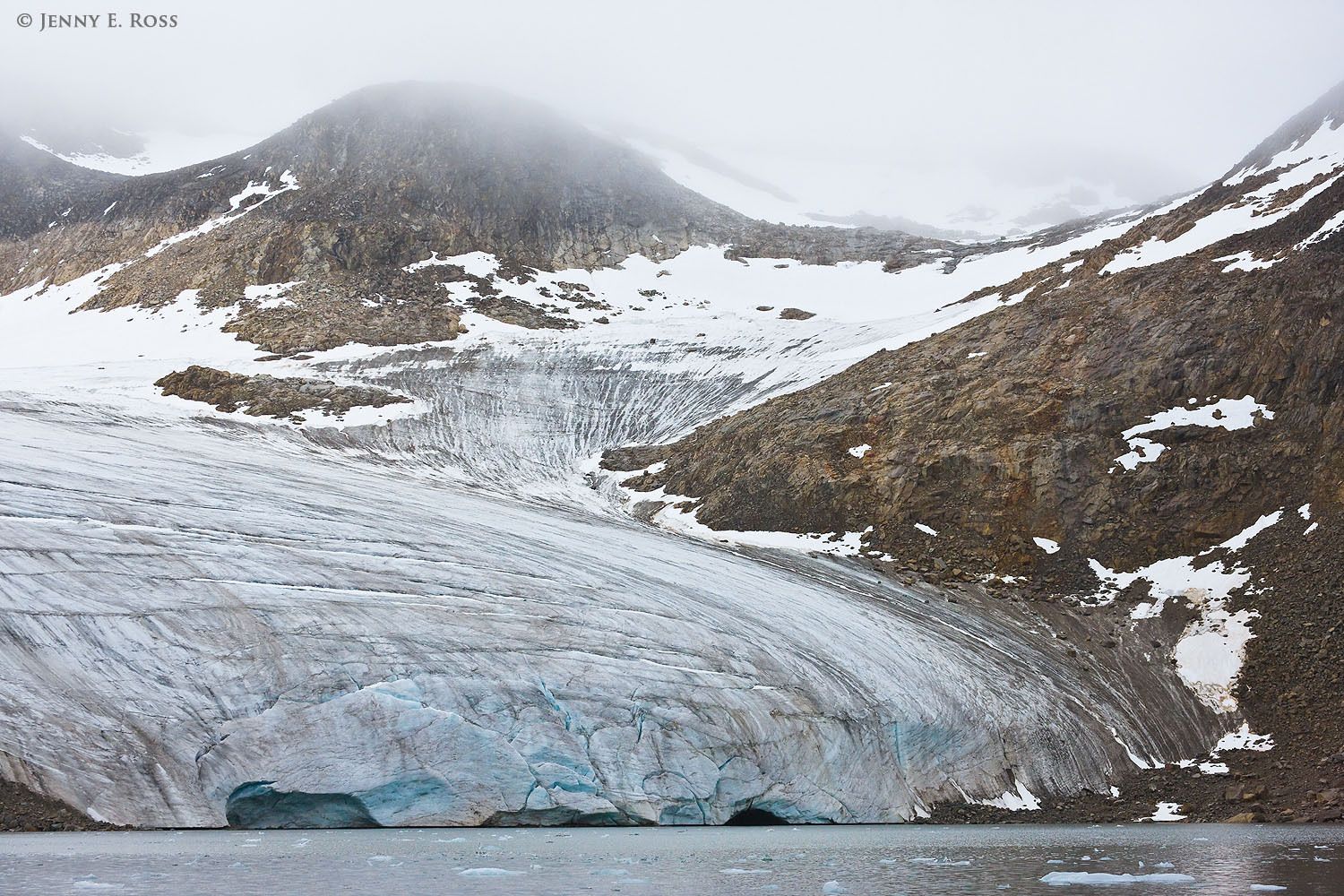-
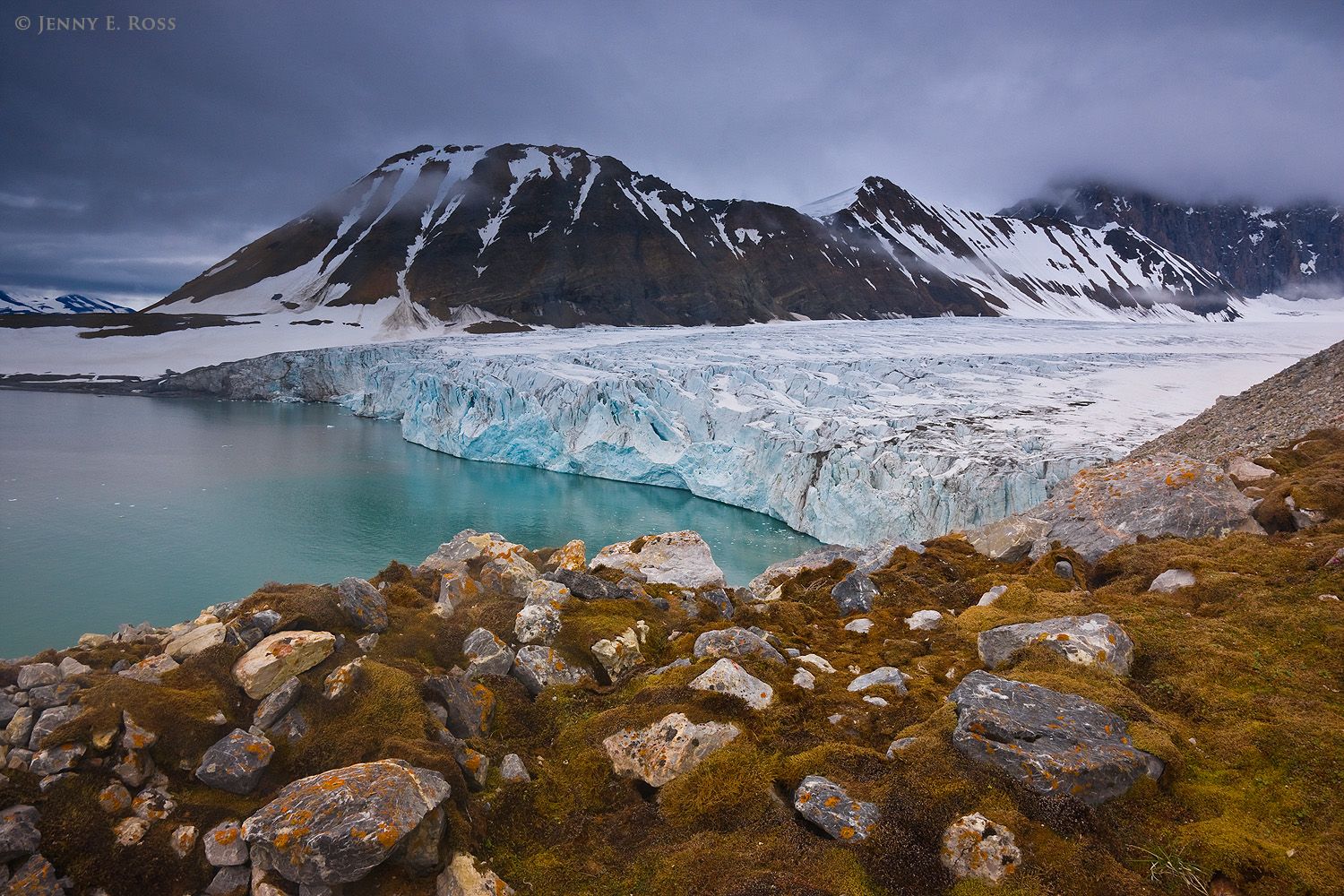
An elevated view of Hansbreen, one of the many spectacular glaciers that enter Hornsund on Spitsbergen in the Svalbard Archipelago, Norway.
-
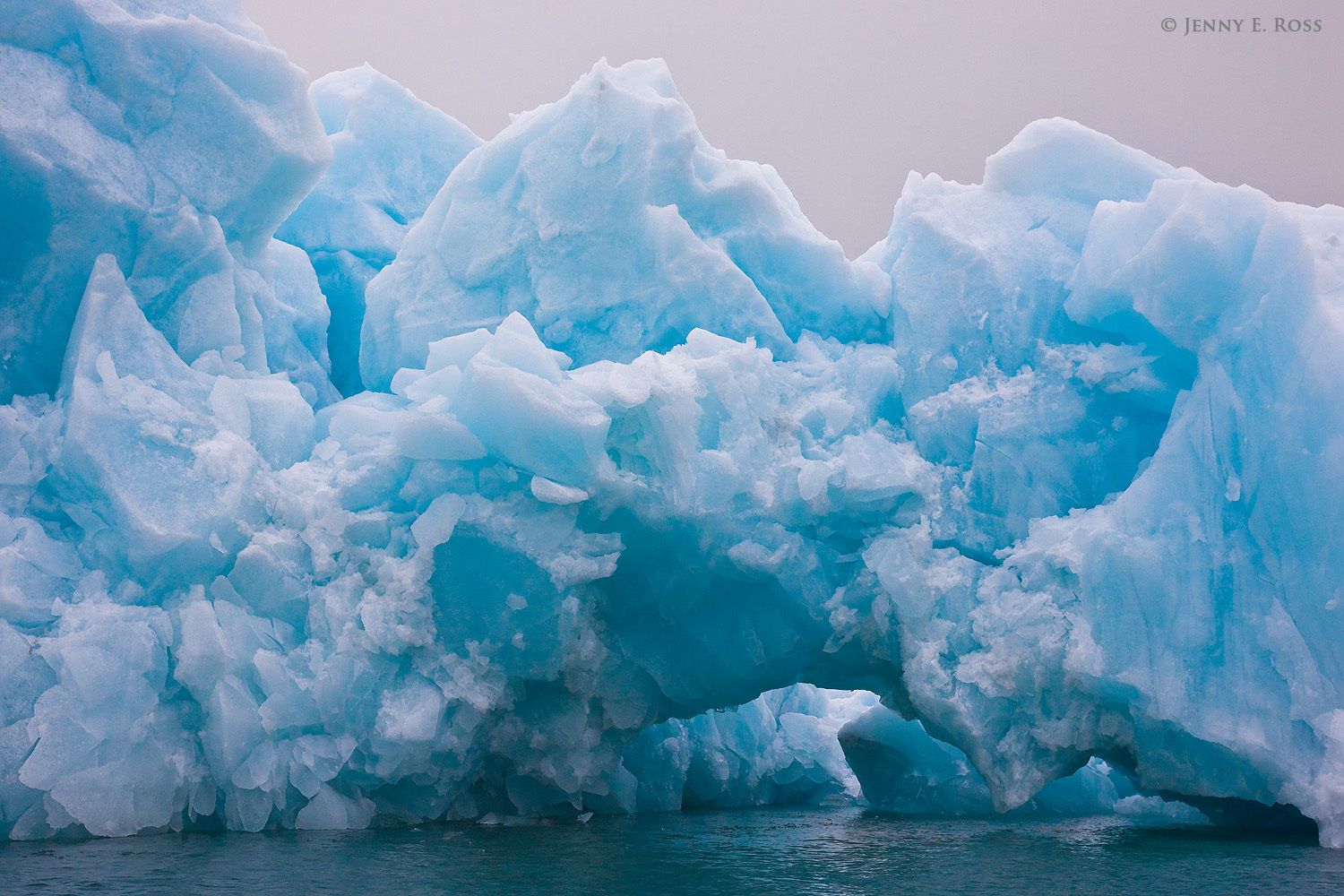
A large iceberg with a natural arch, calved from the Samarinbreen glacier in Samarinvagen on Spitsbergen, Svalbard Archipelago, Norway.
-
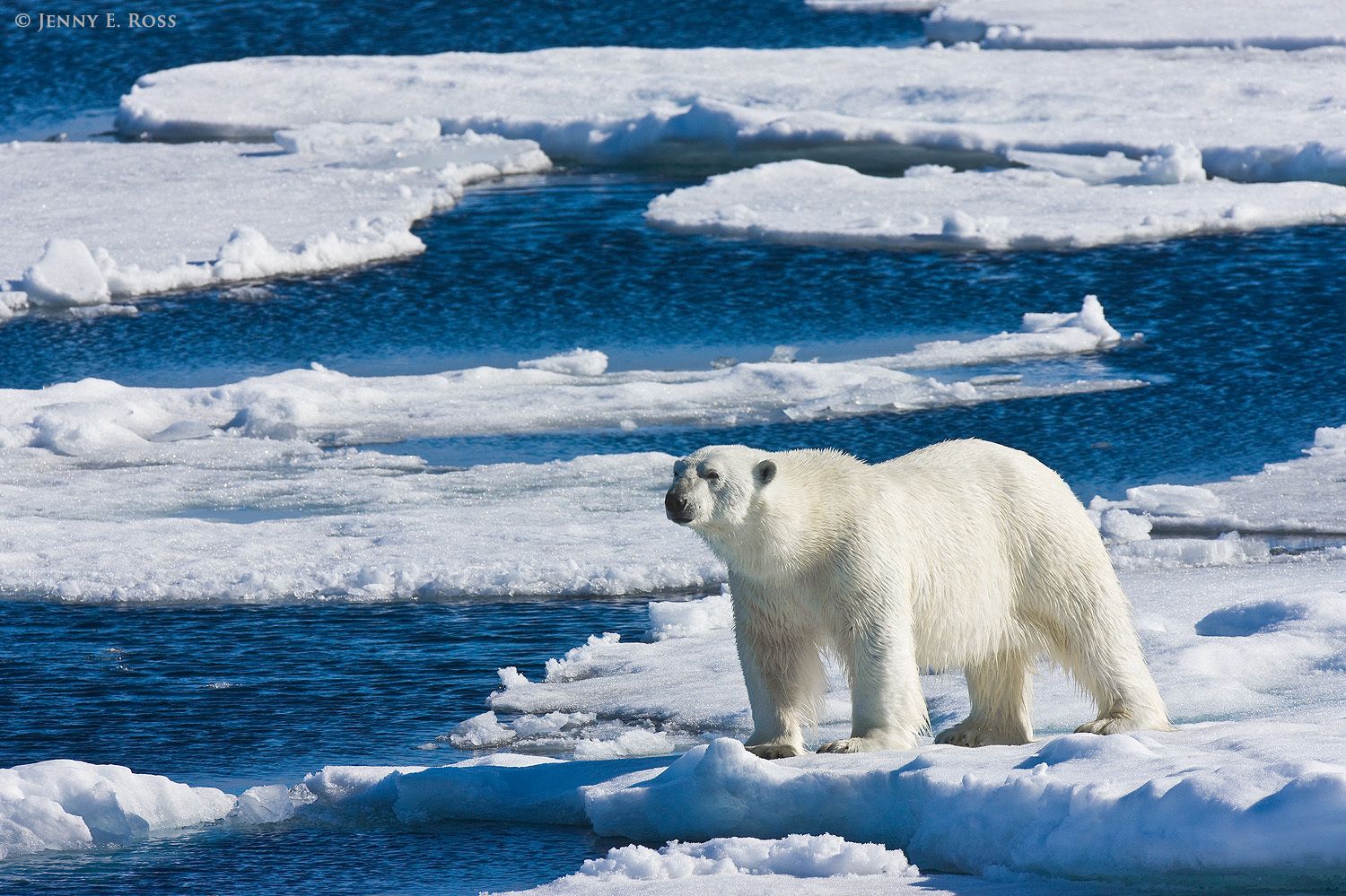
An adult male polar bear on sea ice in the Arctic Ocean north of Svalbard, near 81-degrees North.
-
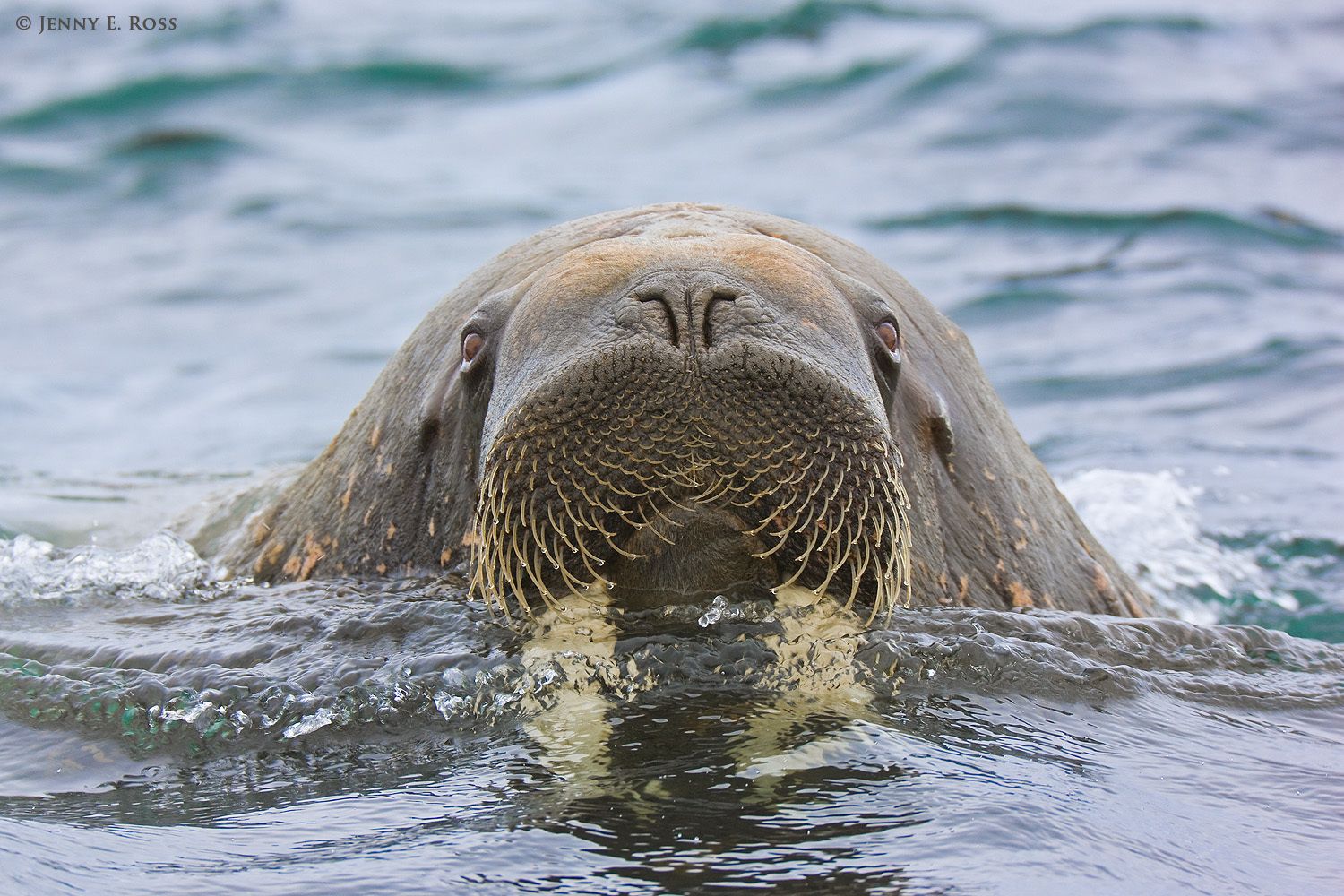
An adult Atlantic Walrus (Odobenus rosmarus rosmarus) near Lagoya Island, in the Svalbard Archipelago, Norway.
-
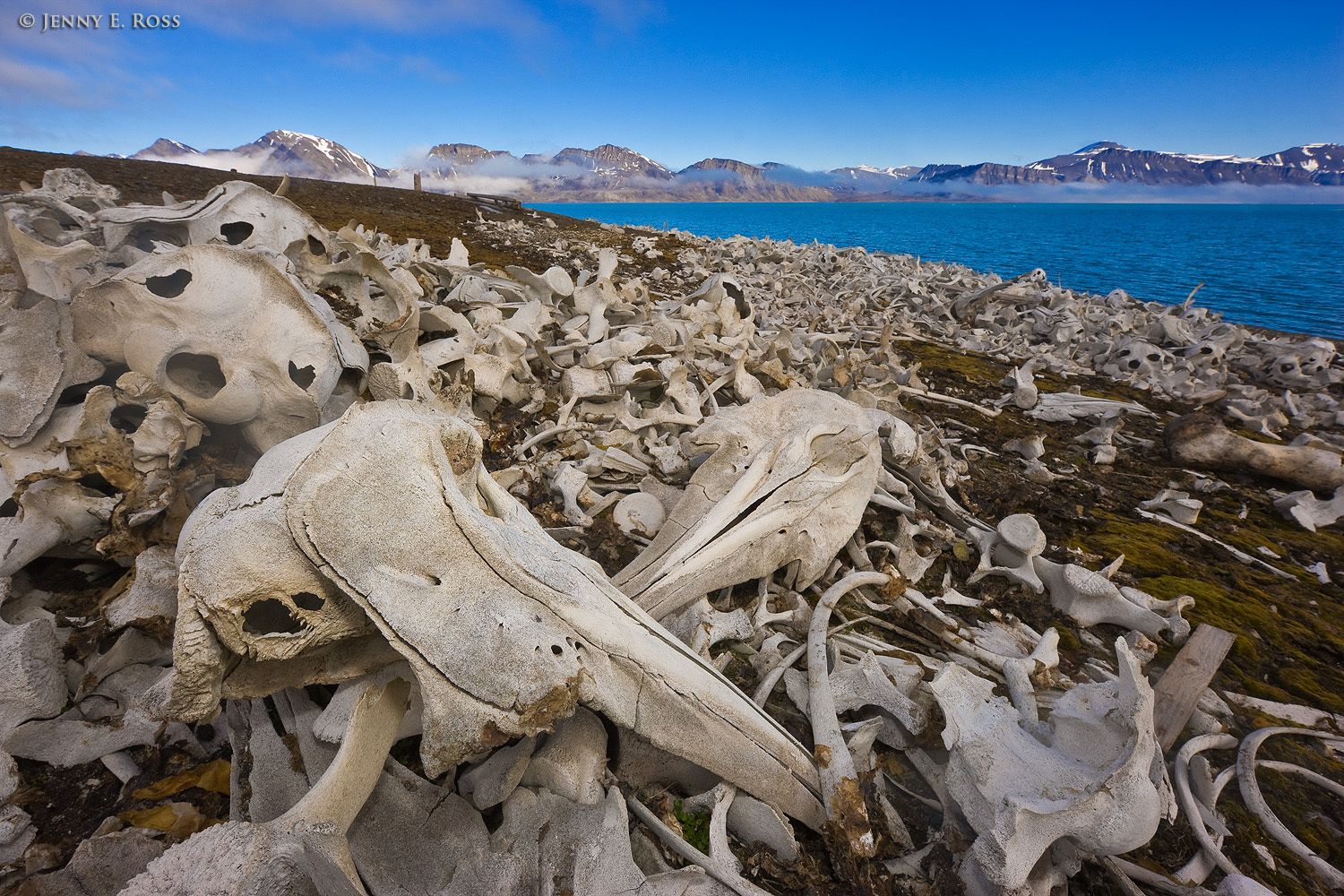
Piles of Beluga Whale bones (Delphinapterus leucas) on the beach at Ahlstrandodden in Bellsund, on the island of Spitsbergen in the Svalbard Archipelago, Norway.
This location was the site of a Norwegian whaling station in the 1930's, where beluga whales were relentlessly hunted until they were nearly extirpated throughout the region.
-
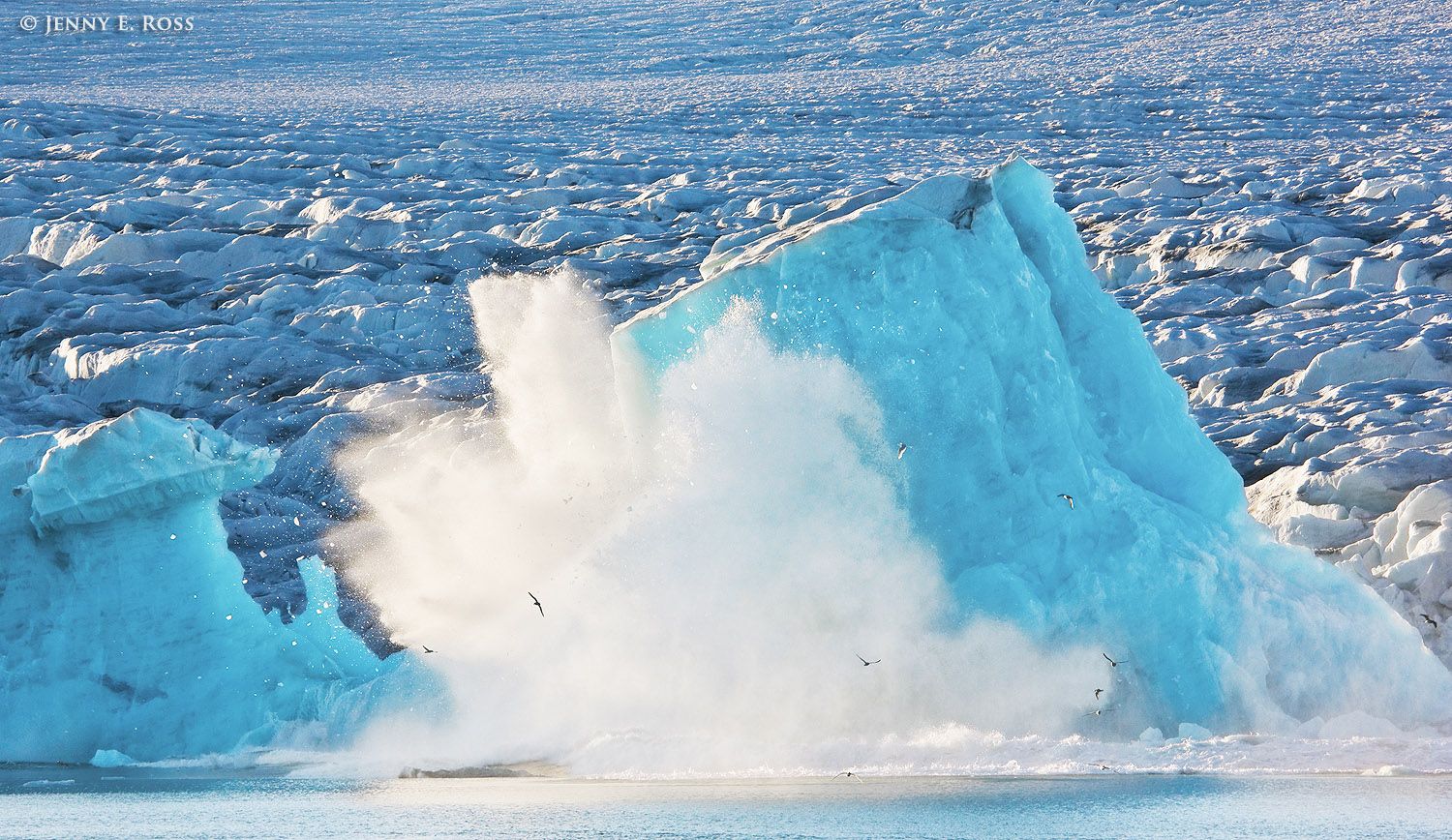
An immense chunk of ice calves away from Lilliehookbreen (Lilliehook Glacier) and collapses into the sea.
Spitsbergen, Svalbard Archipelago, Norway.
-
![An adult Ivory Gull (Pagophila eburnea) on sea ice in the Arctic Ocean north of Svalbard, above 81-degrees North.]()
An adult Ivory Gull (Pagophila eburnea) on sea ice in the Arctic Ocean north of Svalbard, above 81-degrees North.
-
![A polar bear resting on melting summer sea ice in Olgastretet (Barents Sea, Arctic Ocean) within the Svalbard Archipelago, Norway.]()
A polar bear resting on melting summer sea ice in Olgastretet (Barents Sea, Arctic Ocean) within the Svalbard Archipelago, Norway.
-
![A polar bear mother (on right) and her twin cubs (about 2.5 years old) resting on a floe of sea ice in heavy fog, in the Arctic Ocean north of Svalbard above 81-degrees North.]()
A polar bear mother (on right) and her twin cubs (about 2.5 years old) resting on a floe of sea ice in heavy fog, in the Arctic Ocean north of Svalbard above 81-degrees North.
-
![Svalbard Archipelago, Norway. An enormous chunk of ice calves off the face of a glacier in Liefdefjorden, Spitsbergen.]()
An enormous chunk of ice calves off the face of a glacier in Liefdefjorden, Spitsbergen.
Svalbard Archipelago, Norway.
-
![A Svalbard Reindeer (Rangifer tarandus platyrhynchus) on the tundra at Eidembukta on Spitsbergen, in the Svalbard Archipelago, Norway.]()
A Svalbard Reindeer (Rangifer tarandus platyrhynchus) on the tundra at Eidembukta on Spitsbergen, in the Svalbard Archipelago, Norway.
-
![This site is believed to have been used by British whalers from approximately 1618 to 1650. The bowhead whale population throughout the Svalbard region eventually collapsed during the 1700s due to over-hunting, and has never recovered. The bones of numerous bowhead whales, hundreds of years old, lie scattered on the ground in several places along this coastline in the vicinity of the whaling station relics. As they decompose, the bones release nutrients and support small communities of flora, including mosses and low-growing flowering plants. Ancient bowhead whale (Balaena mysticetus) bones slowly decomposing near the remains of a 17th century whaling station at Gashamna in Hornsund on the island of Spitsbergen, Svalbard Archipelago, Norway.]()
Ancient bowhead whale (Balaena mysticetus) bones slowly decomposing near the remains of a 17th century whaling station at Gashamna in Hornsund on the island of Spitsbergen, Svalbard Archipelago, Norway.
This site is believed to have been used by British whalers from approximately 1618 to 1650. The bowhead whale population throughout the Svalbard region eventually collapsed during the 1700s due to over-hunting, and has never recovered. The bones of numerous bowhead whales, hundreds of years old, lie scattered on the ground in several places along this coastline in the vicinity of the whaling station relics. As they decompose, the bones release nutrients and support small communities of flora, including mosses and low-growing flowering plants.
-
![Spitsbergen, Svalbard Archipelago, Norway. Mountains (the tip of Luciakammen) and melting ice in Burgerbukta, Hornsund.]()
Mountains (the tip of Luciakammen) and melting ice in Burgerbukta, Hornsund.
Spitsbergen, Svalbard Archipelago, Norway.
-
![Spitsbergen, Svalbard Archipelago, Norway. A large wave rolls away from the face of Lilliehookbreen (Lilliehook Glacier), following calving and disentegration of an immense chunk of ice.]()
A large wave rolls away from the face of Lilliehookbreen (Lilliehook Glacier), following calving and disentegration of an immense chunk of ice.
Spitsbergen, Svalbard Archipelago, Norway.
-
![An estimated 100,000 pairs of Brunich’s guillemots nest on the cliffs at Alkefjellet, along with tens of thousands of black-legged kittiwakes and a smaller number of several other bird species. Alkefjellet is within the Nordaust-Svalbard Nature Reserve, which is the largest preserved area in Norway. Nesting Brunich’s Guillemots (Uria lomvia) at Alkefjellet, the "guillemot cliffs," in Hinlopenstretet (Hinlopen Strait), within the Svalbard Archipelago, Norway.]()
Nesting Brunich’s Guillemots (Uria lomvia) at Alkefjellet, the "guillemot cliffs," in Hinlopenstretet (Hinlopen Strait), within the Svalbard Archipelago, Norway.
An estimated 100,000 pairs of Brunich’s guillemots nest on the cliffs at Alkefjellet, along with tens of thousands of black-legged kittiwakes and a smaller number of several other bird species. Alkefjellet is within the Nordaust-Svalbard Nature Reserve, which is the largest preserved area in Norway.
-
![An adult Little Auk (Alle alle), aka Dovkie, at the Fuglesangen breeding colony on the island of Spitsbergen in the Svalbard Archipelago, Norway.]()
An adult Little Auk (Alle alle), aka Dovkie, at the Fuglesangen breeding colony on the island of Spitsbergen in the Svalbard Archipelago, Norway.
-
![Svalbard Archipelago, Norway. Little Auks (Alle alle) fly to and from their nesting colony on the scree slopes at Ingeborgfjellet in Vårsolbukta, within Bellsund on the island of Spitsbergen.]()
Little Auks (Alle alle) fly to and from their nesting colony on the scree slopes at Ingeborgfjellet in Vårsolbukta, within Bellsund on the island of Spitsbergen.
Svalbard Archipelago, Norway.
-
![A receding section of Lilliehookbreen (Lilliehook Glacier) in Lilliehook Fjorden on Spitsbergen, in the Svalbard Archipelago, Norway.]()
A receding section of Lilliehookbreen (Lilliehook Glacier) in Lilliehook Fjorden on Spitsbergen, in the Svalbard Archipelago, Norway.
-
![A Svalbard Reindeer antler (Rangifer tarandus platyrhynchus) on the tundra at Signehamna within Lilliehook Fjorden on the island of Spitsbergen in the Svalbard Archipelago, Norway.]()
A Svalbard Reindeer antler (Rangifer tarandus platyrhynchus) on the tundra at Signehamna within Lilliehook Fjorden on the island of Spitsbergen in the Svalbard Archipelago, Norway.
-
![The site of Smeerenburg was first occupied and used for whaling operations in 1614, and was established as a permanent settlement and intensive whaling station in 1619. Whaling operations continued there until about 1660. The ruins of Smeerenburg are now part of Norway's North-West Spitsbergen National Park. Remains of a 17th century blubber oven (including concretized chunks of whale blubber) at Smeerenburg on Amsterdamoya, in the Svalbard Archipelago, Norway.]()
Remains of a 17th century blubber oven (including concretized chunks of whale blubber) at Smeerenburg on Amsterdamoya, in the Svalbard Archipelago, Norway.
The site of Smeerenburg was first occupied and used for whaling operations in 1614, and was established as a permanent settlement and intensive whaling station in 1619. Whaling operations continued there until about 1660. The ruins of Smeerenburg are now part of Norway's North-West Spitsbergen National Park.
-
![An enormous colony of cliff-nesting Black-legged Kittiwakes (Rissa tridactyla) at Raddesletta within Diskobukta, on Edgeoya Island in the Svalbard Archipelago, Norway. All the eggs have hatched, and some of the young birds are beginning to fledge. Colony of cliff-nesting Black-legged Kittiwakes, Svalbard.]()
Colony of cliff-nesting Black-legged Kittiwakes, Svalbard.
An enormous colony of cliff-nesting Black-legged Kittiwakes (Rissa tridactyla) at Raddesletta within Diskobukta, on Edgeoya Island in the Svalbard Archipelago, Norway. All the eggs have hatched, and some of the young birds are beginning to fledge.
-
![Edgeoya Island, Svalbard Archipelago, Norway. An adult Arctic Fox (Alopex lagopus), in dark summer pelage, carrying a fledgling black-legged kittiwake (Rissa tridactyla) it has killed at a nesting colony on the cliffs at Raddesletta within Diskobukta.]()
An adult Arctic Fox (Alopex lagopus), in dark summer pelage, carrying a fledgling black-legged kittiwake (Rissa tridactyla) it has killed at a nesting colony on the cliffs at Raddesletta within Diskobukta.
Edgeoya Island, Svalbard Archipelago, Norway.
-
![Svalbard Archipelago, Norway. An adult Arctic fox (Alopex lagopus), in dark summer pelage, carries a fledgling black-legged kittiwake (Rissa tridactyla) it has just killed at a seabird colony in Diskobukta on Edgeøya.]()
An adult Arctic fox (Alopex lagopus), in dark summer pelage, carries a fledgling black-legged kittiwake (Rissa tridactyla) it has just killed at a seabird colony in Diskobukta on Edgeøya.
Svalbard Archipelago, Norway.
-
![A Bearded Seal (Erignathus barbatus) rests on a small iceberg near the receding glacier Hamiltonbreen in Hamiltonbukta, Spitsbergen, Svalbard.]()
A Bearded Seal (Erignathus barbatus) rests on a small iceberg near the receding glacier Hamiltonbreen in Hamiltonbukta, Spitsbergen, Svalbard.
-
![Brasvellbreen is the third largest ice cap in the world, after Antarctica and Greenland. Brasvellbreen ice cap, Nordaustlandet, Svalbard Archipelago, Norway.]()
Brasvellbreen ice cap, Nordaustlandet, Svalbard Archipelago, Norway.
Brasvellbreen is the third largest ice cap in the world, after Antarctica and Greenland.
-
![This site is believed to have been used by British whalers from approximately 1618 to 1650. The bowhead whale population throughout the Svalbard region eventually collapsed during the 1700s due to over-hunting, and has never recovered. The bones of numerous bowhead whales, several hundred years old, lie scattered on the ground in several places along this coastline in the vicinity of the whaling station remains. As they decompose, the bones release nutrients and support small communities of flora, including mosses and low-growing flowering plants. A large, ancient bowhead whale (Balaena mysticetus) bone lies on the ground, slowly decomposing, near the remains of a 17th century whaling station at Gashamna within Hornsund on the island of Spitsbergen in the Svalbard Archipelago, Norway.]()
A large, ancient bowhead whale (Balaena mysticetus) bone lies on the ground, slowly decomposing, near the remains of a 17th century whaling station at Gashamna within Hornsund on the island of Spitsbergen in the Svalbard Archipelago, Norway.
This site is believed to have been used by British whalers from approximately 1618 to 1650. The bowhead whale population throughout the Svalbard region eventually collapsed during the 1700s due to over-hunting, and has never recovered. The bones of numerous bowhead whales, several hundred years old, lie scattered on the ground in several places along this coastline in the vicinity of the whaling station remains. As they decompose, the bones release nutrients and support small communities of flora, including mosses and low-growing flowering plants.
-
![Adult male polar bears feeding on the remains of a seal kill, on sea ice in the Arctic Ocean north of Svalbard, near 81-degrees North.]()
Adult male polar bears feeding on the remains of a seal kill, on sea ice in the Arctic Ocean north of Svalbard, near 81-degrees North.
-
![An adult male polar bear "still-hunting" on sea ice in the Arctic Ocean north of Svalbard near 81-degrees North.]()
An adult male polar bear "still-hunting" on sea ice in the Arctic Ocean north of Svalbard near 81-degrees North.
-
![A polar bear mother (on right) and her twin cubs (about 2.5 years old) resting on a floe of sea ice in heavy fog, in the Arctic Ocean north of Svalbard above 81-degrees North.]()
A polar bear mother (on right) and her twin cubs (about 2.5 years old) resting on a floe of sea ice in heavy fog, in the Arctic Ocean north of Svalbard above 81-degrees North.
-
![Barents Sea (Arctic Ocean), within the Svalbard Archipelago, Norway. A fog bow arches across scattered floes of melting sea ice in Olgastretet, accompanied by a Brocken spectre and glory. Sunlight shining on fog created the optical phenomena.]()
A fog bow arches across scattered floes of melting sea ice in Olgastretet, accompanied by a Brocken spectre and glory. Sunlight shining on fog created the optical phenomena.
Barents Sea (Arctic Ocean), within the Svalbard Archipelago, Norway.
-
![Svabard Archipelago, Norway. Shrinking glaciers and melting snow in Raudfjorden, viewed from Buchananhalvøya, Spitsbergen.]()
Shrinking glaciers and melting snow in Raudfjorden, viewed from Buchananhalvøya, Spitsbergen.
Svabard Archipelago, Norway.
-
![An adult Svalbard Reindeer (Rangifer tarandus platyrhynchus) pauses while grazing on the tundra near Kapp Lee on Edgeoya in the Svalbard Archipelago, Norway.]()
An adult Svalbard Reindeer (Rangifer tarandus platyrhynchus) pauses while grazing on the tundra near Kapp Lee on Edgeoya in the Svalbard Archipelago, Norway.
-
![The site of Smeerenburg was first occupied and used for whaling operations in 1614, and was established as a permanent settlement and intensive whaling station in 1619. Whaling operations continued there until about 1660. The ruins of Smeerenburg are now part of Norway's North-West Spitsbergen National Park. Remains of a 17th century blubber oven (including concretized chunks of whale blubber) at Smeerenburg on Amsterdamoya, in the Svalbard Archipelago, Norway.]()
Remains of a 17th century blubber oven (including concretized chunks of whale blubber) at Smeerenburg on Amsterdamoya, in the Svalbard Archipelago, Norway.
The site of Smeerenburg was first occupied and used for whaling operations in 1614, and was established as a permanent settlement and intensive whaling station in 1619. Whaling operations continued there until about 1660. The ruins of Smeerenburg are now part of Norway's North-West Spitsbergen National Park.
-
![Brasvellbreen is the third largest ice cap in the world, after Antarctica and Greenland. Brasvellbreen ice cap, Nordaustlandet, Svalbard Archipelago, Norway.]()
Brasvellbreen ice cap, Nordaustlandet, Svalbard Archipelago, Norway.
Brasvellbreen is the third largest ice cap in the world, after Antarctica and Greenland.
-
![Ivory Gulls (Pagophila eburnea) on sea ice in the Arctic Ocean north of Svalbard, above 81-degrees North.]()
Ivory Gulls (Pagophila eburnea) on sea ice in the Arctic Ocean north of Svalbard, above 81-degrees North.
-
![Disintegrating chunks of ice at the calving front of Lilliehookbreen (Lilliehook Glacier) in Lilliehook Fjorden on Spitsbergen in the Svalbard Archipelago, Norway.]()
Disintegrating chunks of ice at the calving front of Lilliehookbreen (Lilliehook Glacier) in Lilliehook Fjorden on Spitsbergen in the Svalbard Archipelago, Norway.
-
![The "patterned ground" phenomenon is caused by frost-heaving of the ground and sorting of rocks and soil particles during repeated freeze-thaw cycles. Patterned ground in the polar desert on Nordaustlandet near the shore of the Arctic Ocean in the Svalbard Archipelago, Norway.]()
Patterned ground in the polar desert on Nordaustlandet near the shore of the Arctic Ocean in the Svalbard Archipelago, Norway.
The "patterned ground" phenomenon is caused by frost-heaving of the ground and sorting of rocks and soil particles during repeated freeze-thaw cycles.
-
![Mountains (Sofiekammen) and melting ice in Burgerbukta, Hornsund, Spitsbergen, Svalbard Archipelago, Norway.]()
Mountains (Sofiekammen) and melting ice in Burgerbukta, Hornsund, Spitsbergen, Svalbard Archipelago, Norway.
-
![Svalbard Archipelago, Norway. An abandoned coal mine, more than 100 years old, on a mountainside near Longyearbyen on Spitsbergen, in the Svalbard Archipelago, Norway.]()
An abandoned coal mine, more than 100 years old, on a mountainside near Longyearbyen on Spitsbergen, in the Svalbard Archipelago, Norway.
Svalbard Archipelago, Norway.
-
![The remains of a cable-car system used in the early part of the 20th century to transport coal from mountain minesto the coast at Longyearbyen on Spitsbergen, in the Svalbard Archipelago, Norway.]()
The remains of a cable-car system used in the early part of the 20th century to transport coal from mountain minesto the coast at Longyearbyen on Spitsbergen, in the Svalbard Archipelago, Norway.
-
![Remains of blubber ovens from the 17th century Dutch whaling station called Harlinger Kokerij, and artifacts from the early 20th century attempt by Walter Wellman to reach the North Pole using an airship, at Virgohamna on Danskoya, in the Svalbard Archipelago, Norway. Amsterdamoya, including the site of the 17th century whaling station Smeerenburg, is in the distance across the narrow waterway. Virgohamna, Danskoya, Spitsbergen, Svalbard]()
Virgohamna, Danskoya, Spitsbergen, Svalbard
Remains of blubber ovens from the 17th century Dutch whaling station called Harlinger Kokerij, and artifacts from the early 20th century attempt by Walter Wellman to reach the North Pole using an airship, at Virgohamna on Danskoya, in the Svalbard Archipelago, Norway. Amsterdamoya, including the site of the 17th century whaling station Smeerenburg, is in the distance across the narrow waterway.
-
![A sign situated at the edge of Ny Ålesund, a tiny remote town in Spitsbergen, warns that it is dangerous to walk on the tundra without a weapon due to the possible presence of polar bears. Ny Ålesund is one of the northernmost settlements in the world, and is the location of a Norwegian Arctic research station. On May 11, 1926 polar explorer Roald Amundsen launched his airship Norge from Ny Ålesund, and landed in Alaska 72 hours later after crossing the North Pole. The anchor mast at his launch site is still standing on the outskirts of Ny Ålesund. A sign warns of polar bear danger near Ny Ålesund on the island of Spitsbergen.]()
A sign warns of polar bear danger near Ny Ålesund on the island of Spitsbergen.
A sign situated at the edge of Ny Ålesund, a tiny remote town in Spitsbergen, warns that it is dangerous to walk on the tundra without a weapon due to the possible presence of polar bears. Ny Ålesund is one of the northernmost settlements in the world, and is the location of a Norwegian Arctic research station. On May 11, 1926 polar explorer Roald Amundsen launched his airship Norge from Ny Ålesund, and landed in Alaska 72 hours later after crossing the North Pole. The anchor mast at his launch site is still standing on the outskirts of Ny Ålesund.
-
![The mast from which the airship Norge was launched on 11 May 1926, carrying Roald Amundsen (expedition leader and navigator), Umberto Nobile (airship designer and pilot) and other crew members, remains standing at its original location near the shore of Ny-Alesund in Svalbard. The Norge passed over the North Pole on 12 May 1926, and arrived in Alaska the following day. Due to the disputed status of other prior claims to have reached the North Pole, the overflight of the Norge on 12 May 1926 is now considered by most historians to be the first confirmed arrival of explorers at the North Pole. Mast for the airship Norge in Ny-Alesund, Svalbard, Norway.]()
Mast for the airship Norge in Ny-Alesund, Svalbard, Norway.
The mast from which the airship Norge was launched on 11 May 1926, carrying Roald Amundsen (expedition leader and navigator), Umberto Nobile (airship designer and pilot) and other crew members, remains standing at its original location near the shore of Ny-Alesund in Svalbard. The Norge passed over the North Pole on 12 May 1926, and arrived in Alaska the following day. Due to the disputed status of other prior claims to have reached the North Pole, the overflight of the Norge on 12 May 1926 is now considered by most historians to be the first confirmed arrival of explorers at the North Pole.
-
![An adult Atlantic Walrus (Odobenus rosmarus rosmarus) at L䨸ya Island in the Svalbard Archipelago, Norway. Atlantic Walrus (Odobenus rosmarus rosmarus)]()
Atlantic Walrus (Odobenus rosmarus rosmarus)
An adult Atlantic Walrus (Odobenus rosmarus rosmarus) at L䨸ya Island in the Svalbard Archipelago, Norway.
-
![Edgeoya, Svalbard Archipelago, Norway. A young Arctic Fox (Alopex lagopus), in dark summer pelage, crosses a fast-moving meltwater stream to hunt for birds.]()
A young Arctic Fox (Alopex lagopus), in dark summer pelage, crosses a fast-moving meltwater stream to hunt for birds.
Edgeoya, Svalbard Archipelago, Norway.
-
![Phippsoya is one of the northernmost islands in Svalbard, and is located within the Sjuoyane (the northernmost cluster of small islands known as"the seven islands"). The latitude was approximately 80.7-degrees North. An adult female polar bear stranded ashore on Phippsoya in Norway's Svalbard Archipelago due to lack of sea ice.]()
An adult female polar bear stranded ashore on Phippsoya in Norway's Svalbard Archipelago due to lack of sea ice.
Phippsoya is one of the northernmost islands in Svalbard, and is located within the Sjuoyane (the northernmost cluster of small islands known as"the seven islands"). The latitude was approximately 80.7-degrees North.
-
![The receding edge of the ice cap on Kvitoya (White Island), the easternmost island in the Svalbard Archipelago.]()
The receding edge of the ice cap on Kvitoya (White Island), the easternmost island in the Svalbard Archipelago.
-
![Atlantic Walruses (Odobenus rosmarus rosmarus) resting on offshore rocks at Kvitoya, the easternmost island in the Svalbard Archipelago, Norway.]()
Atlantic Walruses (Odobenus rosmarus rosmarus) resting on offshore rocks at Kvitoya, the easternmost island in the Svalbard Archipelago, Norway.
-
![The island's ice cap is in the background, beyond the beach ridge. A young adult male polar bear (Ursus maritimus) stranded ashore on Storoya in Norway's Svalbard Archipelago due to lack of sea ice.]()
A young adult male polar bear (Ursus maritimus) stranded ashore on Storoya in Norway's Svalbard Archipelago due to lack of sea ice.
The island's ice cap is in the background, beyond the beach ridge.
-
![Black-legged Kittiwakes (Rissa tridactyla) and Skuas at the ice cap on Kvitoya (White Island), the easternmost island in the Svalbard Archipelago.]()
Black-legged Kittiwakes (Rissa tridactyla) and Skuas at the ice cap on Kvitoya (White Island), the easternmost island in the Svalbard Archipelago.
-
![The receding glacier Hamiltonbreen in Hamiltonbukta on Spitsbergen in the Svalbard Archipelago, Norway.]()
The receding glacier Hamiltonbreen in Hamiltonbukta on Spitsbergen in the Svalbard Archipelago, Norway.
-
![Detail of the receding glacier Hamiltonbreen in Hamiltonbukta on Spitsbergen in the Svalbard Archipelago, Norway.]()
Detail of the receding glacier Hamiltonbreen in Hamiltonbukta on Spitsbergen in the Svalbard Archipelago, Norway.
-
![Alkefjellet is within the Nordaust-Svalbard Nature Reserve, which is the largest preserved area in Norway. Pink-footed geese (Anser brachyrhynchus) rest on melting ice at the base of a towering cliff, next to an immense waterfall fed by glacial meltwater. Alkefjellet, Hinlopenstretet (Hinlopen Strait), Svalbard Archipelago, Norway.]()
Pink-footed geese (Anser brachyrhynchus) rest on melting ice at the base of a towering cliff, next to an immense waterfall fed by glacial meltwater. Alkefjellet, Hinlopenstretet (Hinlopen Strait), Svalbard Archipelago, Norway.
Alkefjellet is within the Nordaust-Svalbard Nature Reserve, which is the largest preserved area in Norway.
-
![A receding section of the Samarinbreen glacier in Samarinvagen on Spitsbergen in the Svalbard Archipelago, Norway.]()
A receding section of the Samarinbreen glacier in Samarinvagen on Spitsbergen in the Svalbard Archipelago, Norway.
-
![This location was the site of a Norwegian whaling station in the 1930's, where beluga whales were relentlessly hunted until they were nearly extirpated throughout the region. The disintegrating remains of small whaling boats and a large pile of Beluga Whale bones (Delphinapterus leucas) on the beach at Ahlstrandodden in Bellsund, on the island of Spitsbergen in the Svalbard Archipelago, Norway.]()
The disintegrating remains of small whaling boats and a large pile of Beluga Whale bones (Delphinapterus leucas) on the beach at Ahlstrandodden in Bellsund, on the island of Spitsbergen in the Svalbard Archipelago, Norway.
This location was the site of a Norwegian whaling station in the 1930's, where beluga whales were relentlessly hunted until they were nearly extirpated throughout the region.
-
![An adult Little Auk (Alle alle), aka Dovkie, at the Fuglesangen breeding colony on the island of Spitsbergen in the Svalbard Archipelago, Norway.]()
An adult Little Auk (Alle alle), aka Dovkie, at the Fuglesangen breeding colony on the island of Spitsbergen in the Svalbard Archipelago, Norway.
-
![Harbor seals (Phoca vitulina) at Virgohamna on Danskoya in the Svalbard Archipelago, Norway.]()
Harbor seals (Phoca vitulina) at Virgohamna on Danskoya in the Svalbard Archipelago, Norway.
-
![This site is believed to have been used by British whalers from approximately 1618 to 1650. The bowhead whale population throughout the Svalbard region eventually collapsed during the 1700s due to over-hunting, and has never recovered. The bones of numerous bowhead whales, several hundred years old, lie scattered on the ground in several places along this coastline in the vicinity of the whaling station remains. As they decompose, the bones release nutrients and support small communities of flora, including mosses and low-growing flowering plants. Ancient bowhead whale (Balaena mysticetus) bones lie on the ground, slowly decomposing, near the remains of a 17th century whaling station at Gåshamna, Hornsund, Spitsbergen, Svalbard Archipelago, Norway.]()
Ancient bowhead whale (Balaena mysticetus) bones lie on the ground, slowly decomposing, near the remains of a 17th century whaling station at Gåshamna, Hornsund, Spitsbergen, Svalbard Archipelago, Norway.
This site is believed to have been used by British whalers from approximately 1618 to 1650. The bowhead whale population throughout the Svalbard region eventually collapsed during the 1700s due to over-hunting, and has never recovered. The bones of numerous bowhead whales, several hundred years old, lie scattered on the ground in several places along this coastline in the vicinity of the whaling station remains. As they decompose, the bones release nutrients and support small communities of flora, including mosses and low-growing flowering plants.
-
![Svalbard Archipelago, Norway. An adult Atlantic Walrus (Odobenus rosmarus rosmarus) swims in the Arctic Ocean near Lågøya Island.]()
An adult Atlantic Walrus (Odobenus rosmarus rosmarus) swims in the Arctic Ocean near Lågøya Island.
Svalbard Archipelago, Norway.
-
![The ablation zone of Nathorstbreen, a glacier that is currently surging rapidly, in Van Keulenfjord within Bellsund, on the island of Spitsbergen in the Svalbard Archipelago, Norway.]()
The ablation zone of Nathorstbreen, a glacier that is currently surging rapidly, in Van Keulenfjord within Bellsund, on the island of Spitsbergen in the Svalbard Archipelago, Norway.
-
![Formed by very strong high-elevation winds over mountain peaks, dramatic lenticular clouds soar above Hamiltonbukta in the northwest region of the island of Spitsbergen in the Svalbard Archipelago, Norway.]()
Formed by very strong high-elevation winds over mountain peaks, dramatic lenticular clouds soar above Hamiltonbukta in the northwest region of the island of Spitsbergen in the Svalbard Archipelago, Norway.
-
![Sunlight shining on disappearing fog created this optical phenomenon. There was only thin and scattered sea ice in this region of the Arctic Ocean north of the Svalbard Archipelago in late July, at a location near 81 degrees North -- far less ice than has covered the region historically. Climate change is rapidly shrinking the sea ice in this area and many other parts of the Arctic. A fog bow arches across the Arctic Ocean, above fractured and melting floes of sea ice.]()
A fog bow arches across the Arctic Ocean, above fractured and melting floes of sea ice.
Sunlight shining on disappearing fog created this optical phenomenon. There was only thin and scattered sea ice in this region of the Arctic Ocean north of the Svalbard Archipelago in late July, at a location near 81 degrees North -- far less ice than has covered the region historically. Climate change is rapidly shrinking the sea ice in this area and many other parts of the Arctic.





















